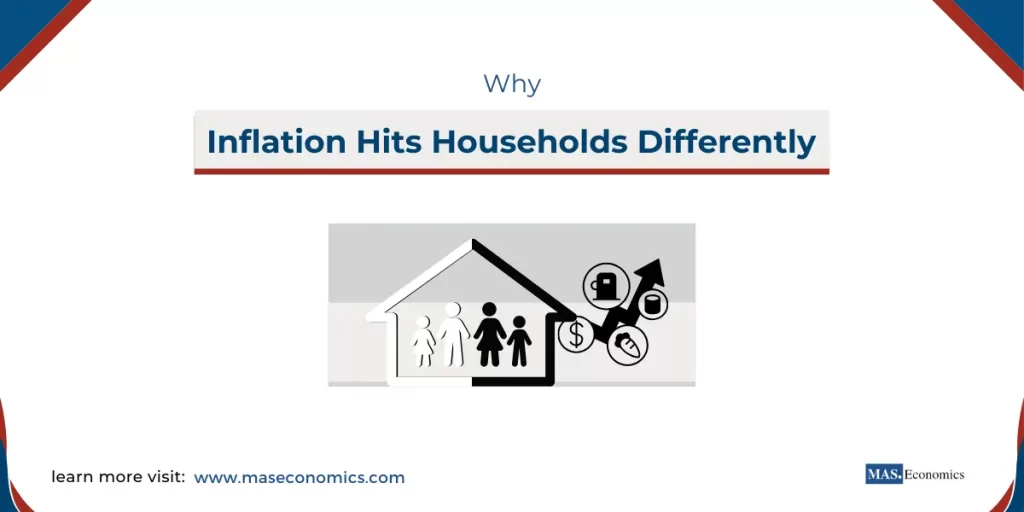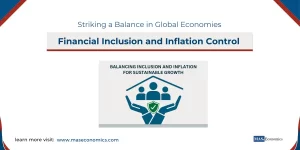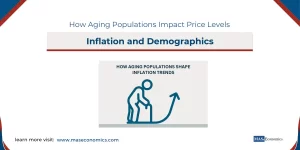Inflation impacts nearly everyone, but its effects are far from uniform. For households, the rising cost of goods and services can have markedly different consequences, influencing quality of life in varied ways. These disparities arise from several critical factors, including income levels, consumption patterns, and regional circumstances. Examining why inflation affects households differently provides valuable insights into how unique situations shape individual experiences with rising prices.
Inflation and Household Budgets
The recent surge in inflation between 2021 and 2023 serves as a stark reminder of how inflationary pressures can impact households differently. During this period, essential items such as gas, electricity, and food saw substantial price increases. Gas prices rose by 96%, while electricity increased by 54%, and even staple food items like milk, cheese, and eggs rose by 22%. These sudden price hikes were partly fueled by the economic recovery from the COVID-19 pandemic and the geopolitical effects of the war in Ukraine.
While these increases are alarming on their own, how they impact households depends on each family’s unique financial and lifestyle situation. To truly understand this, we need to consider three primary factors: income levels, consumption patterns, and regional cost variations.
Income Levels: Fixed vs. Flexible Budgets
The effect of inflation on a household depends heavily on income levels. Households with higher incomes often have more financial flexibility. They tend to spend a smaller proportion of their income on essentials, which makes it easier for them to absorb price increases without having to significantly alter their spending habits. For instance, higher-income households might spend a significant portion of their budget on non-essentials, allowing them to reallocate resources when the cost of basics rises.
Low-income households, on the other hand, face a much starker reality. With a larger share of their budget devoted to basic necessities like rent, food, and utilities, any increase in the price of these items directly impacts their ability to make ends meet. For many lower-income families, there simply isn’t much discretionary spending that can be cut when prices go up. Consequently, these households may face choices between heating their homes and buying enough food.
Imagine a household with an annual income of £29,500—the median income in the UK. With inflation at 5% per year, over the next decade, this household would see its purchasing power eroded dramatically. If the same household spends £26,000 per year, after 10 years at 5% inflation, they would need about £42,351 to afford the same lifestyle—a steep rise that forces households on fixed incomes to sacrifice quality of life as their expenses outpace their stagnant earnings.
Consumption Patterns
Another key factor that affects how inflation impacts households is consumption patterns. Not all households spend their money in the same way, and this is a crucial distinction when it comes to understanding inflation’s effects.
For instance, if inflation is largely driven by energy prices, households that spend more of their budget on gas and electricity—like those living in poorly insulated homes or in colder regions—will feel the impact more acutely than those that do not. Likewise, families with young children, who may have high consumption of products like dairy, can be disproportionately affected if food prices surge.
Differential Impact by Spending Categories
Consumption baskets differ widely between households depending on demographic and socioeconomic characteristics. For instance:
Families with Children
Spending on goods like milk, eggs, and cheese is likely to be higher for households with children. When inflation disproportionately affects food items, these families experience a greater squeeze on their disposable income.
Retired Individuals
Retirees often spend a larger portion of their income on healthcare and home utilities. Rising energy costs, therefore, hit these households especially hard, making it difficult to adjust spending in other areas.
Young Professionals
Younger people might spend more on housing and transportation. Inflation driven by rising rental prices or fuel costs will disproportionately affect their spending power.
This diversity in spending patterns means that even if the overall inflation rate remains constant, the personal inflation rate experienced by different households can vary significantly.
Regional Differences
Regional cost variations also play an essential role in determining how inflation affects households. Prices for the same goods can vary dramatically depending on where you live, meaning that inflation’s effects are not uniform across different parts of a country.
In urban areas, for example, the cost of housing tends to be significantly higher than in rural areas. During periods of inflation, urban households may feel the impact more because they are already allocating a larger portion of their income to cover housing costs. On the other hand, rural households might be more vulnerable to increases in transportation costs, given the necessity of traveling longer distances for work, school, or even basic shopping.
How the CPI Fails to Capture Individual Household Experiences
The Consumer Price Index (CPI) is the most widely recognized measure of inflation, but it has significant limitations when it comes to understanding the different impacts on individual households. The CPI measures the average price change for a “basket of goods” intended to represent the typical household, but it does not differentiate based on income levels, regional differences, or spending habits.
CPI Calculation
The Laspeyres index method, used for CPI, applies fixed weights based on a base-year basket of goods:
\( L = \left( \frac{\sum (P_t \times Q_0)}{\sum (P_0 \times Q_0)} \right) \times 100 \)
Where:
- Pt: Price of the item in the current period
- P0: Price of the item in the base period
- Q0: Quantity of the item in the base period
While this method effectively captures the change in prices, it fails to account for consumer substitution. If the price of beef rises significantly, many households may switch to chicken, but the Laspeyres index does not capture this adaptive behavior. Thus, the CPI may overestimate the actual cost of living for many households.
Moreover, the CPI does not reflect differences between households. A rural household that spends a lot on energy will have a different inflation experience compared to an urban household where housing costs dominate. This highlights why the general CPI may not always provide an accurate reflection of individual experiences of inflation.
Inflation and Indexation
Inflation doesn’t just influence the cost of goods; it also affects wages, benefits, and pensions. Indexation—the process of adjusting income by inflation—is critical for maintaining living standards during times of rising prices.
However, indexation is not applied equally across all types of income. Public benefits and pensions, for instance, are often adjusted based on inflation, but the level of adjustment can vary. Some benefits are linked to the CPI, while others are subject to political discretion, meaning they might be increased less than inflation or even frozen during periods of fiscal austerity.
Real vs. Nominal Adjustments
Consider the state pension. Ideally, this pension should be adjusted for inflation to maintain its real value over time, allowing retirees to afford the same basket of goods and services year after year. However, due to political decisions, there have been periods where pensions increased by less than the rate of inflation, leading to a decline in purchasing power. This disparity between nominal increases (the actual sum of money received) and real increases (what that money can buy) creates a burden, particularly for those reliant solely on pension income.
Wage Adjustments and the Risk of an Inflationary Spiral
For those in employment, wage adjustments play a crucial role in mitigating the effects of inflation. In theory, wages should rise in line with the CPI to ensure that workers maintain their purchasing power. However, this is not always the case, and often wage increases lag behind inflation rates.
When wages do increase rapidly in response to inflation, there is a risk of creating a wage-price spiral. Employers pass the increased labor costs onto consumers in the form of higher prices, which in turn fuels further inflation. This phenomenon was evident during the inflationary periods of the 1970s, where spiraling wages and prices led to prolonged economic instability. Today concerns over such a spiral are one reason why governments and employers may be cautious about making inflation-matching wage increases.
The Personal Inflation Rate
The concept of a personal inflation rate is often more useful for understanding how price changes affect an individual household. A personal inflation rate considers a household’s unique spending habits and provides a more accurate measure of how inflation affects their cost of living.
To calculate a personal inflation rate, households would apply the inflation rate of individual items they typically purchase to their spending basket:
\( PIR = \left( \frac{\sum (w_i \times r_i)}{\sum w_i} \right) \)
Where:
- wi: Weight of the item in the household’s spending (as a percentage)
- ri: Inflation rate for the specific item
By using a personalized basket, individuals can better understand why their experience with inflation might differ from the national average.
Policy Implications
Policymakers need to be aware of inflation’s disparate impact on different segments of society and create targeted measures to alleviate its effects. For low-income households, direct support measures like energy rebates or increased food subsidies can help cushion the blow of rising costs. The government’s intervention during the energy crisis, such as providing rebates and setting price caps, illustrates one approach to mitigating the unequal effects of inflation.
Moreover, better measures of inflation are needed to capture the varied experiences across households. While the CPI serves its purpose as a broad indicator, complementary indices like the Household Costs Indices (HCI) can provide more nuanced insights, especially for policymakers looking to support the most vulnerable groups.
Conclusion
Inflation is not just about numbers on a chart—it’s about how those numbers translate into everyday life. Why inflation hits households differently becomes evident when considering factors like income, spending habits, and regional differences. The recent periods of high inflation have highlighted these disparities, showing that some households are far more vulnerable to rising prices than others.
FAQs:
What factors cause inflation to affect households differently?
Inflation impacts households differently due to variations in income levels, spending habits, and regional costs. High-income households can often absorb price increases more easily than low-income households, which spend a larger share of their budget on essentials. Regional differences, such as housing and energy costs, also play a role in how inflation is experienced.
How do income levels influence a household’s experience with inflation?
Income levels significantly affect how households cope with inflation. Higher-income households typically spend less of their income on essentials like food and energy, making them less vulnerable to price increases in these categories. In contrast, low-income households devote a larger portion of their budget to necessities, leaving them more exposed to inflationary pressures.
Why do consumption patterns affect the impact of inflation on households?
Consumption patterns determine how much a household spends on different goods and services. Households that spend more on items experiencing higher inflation—like energy or food—will feel the effects more acutely. For example, families with children may be more affected by rising food prices, while retirees might be more sensitive to increases in healthcare or utility costs.
How do regional differences influence the effect of inflation?
Regional differences can cause inflation to impact households in varied ways. Urban areas often have higher housing costs, making inflation in this sector more impactful for city dwellers. In contrast, rural households might be more affected by increases in transportation costs due to greater reliance on personal vehicles for commuting.
Why doesn’t the Consumer Price Index (CPI) fully reflect individual household inflation experiences?
The CPI measures average price changes for a standard basket of goods, but it doesn’t account for individual spending habits or regional cost variations. Different households have unique consumption patterns, which means their personal inflation rate could differ significantly from the national average reported by the CPI.
What is substitution bias, and how does it affect inflation measurement?
Substitution bias occurs when the CPI does not account for consumers switching to cheaper alternatives when prices rise. For example, if beef prices increase significantly, consumers might buy more chicken instead. Since the CPI often uses a fixed basket of goods, it may overstate inflation by not reflecting these changes in consumer behavior.
How does inflation affect wages, benefits, and pensions?
Inflation can erode the purchasing power of wages, benefits, and pensions if they are not adjusted accordingly. While some incomes are indexed to inflation, ensuring they rise with price levels, others may not, leading to a real decline in purchasing power over time. This is particularly challenging for fixed-income groups like retirees.
What is the risk of a wage-price spiral during inflation?
A wage-price spiral occurs when wages rise in response to inflation, leading to increased production costs, which companies then pass on to consumers as higher prices. This cycle can fuel further inflation, making it difficult to stabilize prices without significant intervention, such as raising interest rates or tightening monetary policy.
How can households calculate their personal inflation rate?
Households can calculate their personal inflation rate by tracking their spending on various goods and services and applying the specific inflation rate for each category. This approach provides a more accurate picture of how inflation affects their unique financial situation compared to the broader CPI.
Thanks for reading! Share this with friends and spread the knowledge if you found it helpful.
Happy learning with MASEconomics




